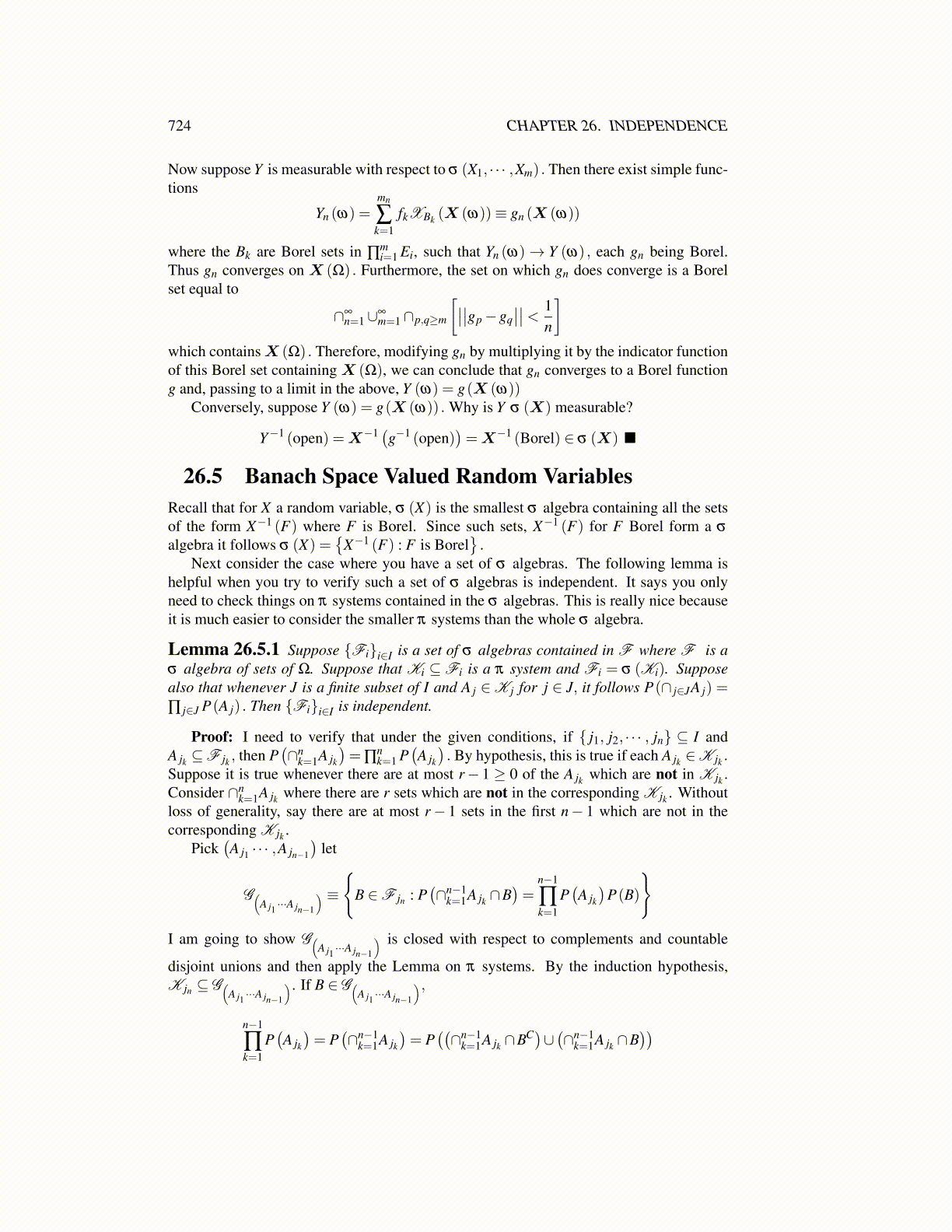
724 CHAPTER 26. INDEPENDENCE
Now suppose Y is measurable with respect to σ (X1, · · · ,Xm) . Then there exist simple func-tions
Yn (ω) =mn
∑k=1
fkXBk (X (ω))≡ gn (X (ω))
where the Bk are Borel sets in ∏mi=1 Ei, such that Yn (ω)→ Y (ω) , each gn being Borel.
Thus gn converges on X (Ω) . Furthermore, the set on which gn does converge is a Borelset equal to
∩∞n=1∪∞
m=1∩p,q≥m
[∣∣∣∣gp−gq∣∣∣∣< 1
n
]which containsX (Ω) . Therefore, modifying gn by multiplying it by the indicator functionof this Borel set containing X (Ω), we can conclude that gn converges to a Borel functiong and, passing to a limit in the above, Y (ω) = g(X (ω))
Conversely, suppose Y (ω) = g(X (ω)) . Why is Y σ (X) measurable?
Y−1 (open) =X−1 (g−1 (open))=X−1 (Borel) ∈ σ (X) ■
26.5 Banach Space Valued Random VariablesRecall that for X a random variable, σ (X) is the smallest σ algebra containing all the setsof the form X−1 (F) where F is Borel. Since such sets, X−1 (F) for F Borel form a σ
algebra it follows σ (X) ={
X−1 (F) : F is Borel}.
Next consider the case where you have a set of σ algebras. The following lemma ishelpful when you try to verify such a set of σ algebras is independent. It says you onlyneed to check things on π systems contained in the σ algebras. This is really nice becauseit is much easier to consider the smaller π systems than the whole σ algebra.
Lemma 26.5.1 Suppose {Fi}i∈I is a set of σ algebras contained in F where F is aσ algebra of sets of Ω. Suppose that Ki ⊆Fi is a π system and Fi = σ (Ki). Supposealso that whenever J is a finite subset of I and A j ∈K j for j ∈ J, it follows P(∩ j∈JA j) =
∏ j∈J P(A j) . Then {Fi}i∈I is independent.
Proof: I need to verify that under the given conditions, if { j1, j2, · · · , jn} ⊆ I andA jk ⊆F jk , then P
(∩n
k=1A jk
)= ∏
nk=1 P
(A jk
). By hypothesis, this is true if each A jk ∈K jk .
Suppose it is true whenever there are at most r− 1 ≥ 0 of the A jk which are not in K jk .Consider ∩n
k=1A jk where there are r sets which are not in the corresponding K jk . Withoutloss of generality, say there are at most r− 1 sets in the first n− 1 which are not in thecorresponding K jk .
Pick(A j1 · · · ,A jn−1
)let
G(A j1 ···A jn−1
) ≡{
B ∈F jn : P(∩n−1
k=1A jk ∩B)=
n−1
∏k=1
P(A jk
)P(B)
}I am going to show G(
A j1 ···A jn−1
) is closed with respect to complements and countable
disjoint unions and then apply the Lemma on π systems. By the induction hypothesis,K jn ⊆ G(
A j1 ···A jn−1
). If B ∈ G(A j1 ···A jn−1
),n−1
∏k=1
P(A jk
)= P
(∩n−1
k=1A jk
)= P
((∩n−1
k=1A jk ∩BC)∪ (∩n−1k=1A jk ∩B
))